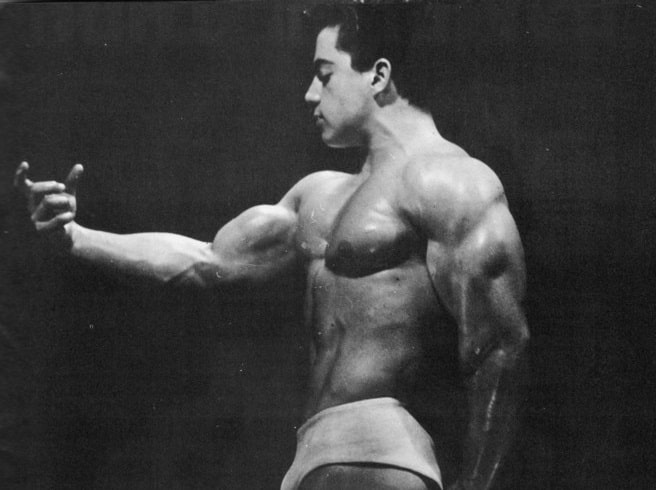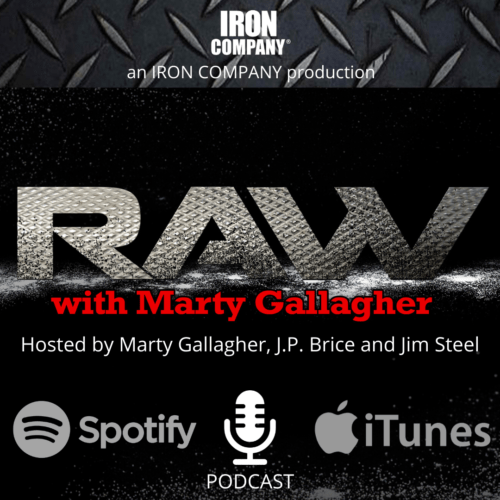
Why we love the Power Clean
It’s called a ‘quick lift’ for a reason
Marvin Eder 1956 (above): Pre-steroid, he overhead pressed 355-pounds in competition weighing 195. His power clean technique was terrible – yet still, he cleaned the 355 before he pressed it. For Eder, and a lot of lifters, the power clean was more difficult than the overhead press and became the limiting factor. Eder would have overhead pressed 400-pounds drug-free weighing 195-pounds if spared having to clean the weight before pressing it.
Until the late 1960s, the number one test of upper body strength was the overhead barbell press and not the bench press. As primal as it sounds, the standardized weight bench for bench pressing, a flat bench with upright supports to hold a barbell, had yet to be invented. If you wanted to bench press, you had a flat bench and you had squat racks and could drag the two together. Or you could have two training partners hand you the loaded barbell. Until the mid-sixties the bench press was not popular enough to warrant the production of a bench with upright supports.
Up until 1965, the gold standard for upper body strength was not, ‘how much can you bench press?’ it was, ‘how much can you (clean and overhead) press?’ One of the real problems with getting good at overhead pressing was that the overhead press was two lifts: a power clean preceded the press. Technically, getting the weight to the shoulders was a whole lot more complicated than pushing it overhead.
A proper power clean uses leg power to initiate a long upward pull. The spinal erectors and lower lats jump in to assist the legs as the Olympic bar leaves the floor. To complete the final phase, the “top pull,” the trapezius and rear deltoids fire. In a perfectly executed power clean, the athlete generates enough explosive power on the upward pull that once the pull phase is completed, the barbell continues to rise for a split-second and as the barbell continues to travel upward, the lifter dips, flips his wrists and catches the barbell on its now downward path, “racking it” on the shoulders, thus completing the power clean.
An efficient power clean leaves more strength available for the overhead press, conversely, poor PC technique, struggling with a power clean, dramatically reduces strength for pressing. For many lifters the frustrating fact was the clean preceding the press became the limiting factor. A poorly executed power clean lacks any explosiveness. Muscling up a power clean can be dangerous as recklessly ripping and jerking on a heavy barbell is asking for injury.
How is a proper power clean performed? You need to be stronger than the weight. If the poundage is too heavy, while you can pull it upward, it will lack any semblance of velocity. Without velocity a power clean becomes an upright row. If you are unable to generate speed, back down in poundage. You need be able to pull fast enough and long enough to create the upward momentum that allows the lifter that split-second needed to dip and simultaneously snap the wrists over, racking the weight. If you can’t, the weight is too heavy.
Elite Olympic lifters will only perform singles and doubles in the power clean. And there are no negative reps in Olympic weightlifting. The idea behind low reps is simple: in order to generate true velocity, the central nervous system needs to be fresh. Past two reps per set and the CNS is zapped. All subsequent reps will lack the requisite velocity, degrading the lift to an unacceptable degree. 5-rep sets, the benchmark rep range for the powerlifts and overhead press, are totally inappropriate for power cleans. How would a smart trainee incorporate power cleans into their training template? Power cleans make for an excellent way to start a back training session and make a terrific warm-up for the deadlift. Here is a classical power training “back day” session, done once a week…
| Power clean | five sets, 2-rep sets; start ultra-light, establish velocity, small poundage jumps |
| Deadlift | five sets, 2 warmup sets, pyramid up to a top set of 3-5 reps |
| Barbell row | four sets of 5-reps, progressive, use straps |
| Pullups or pulldown | four sets of 8-10 reps, stress stretch and contraction, not poundage |
| Chins/under-grip pulldown | four sets of 8-10 reps, stress stretch and contraction, not poundage |
| Prone hyper-extension | one set to failure, 12-15 reps, seek to rise higher on each rep, final back pump |
Power cleans needs to be snappy and precise. Power cleans are always done first in any workout they are a part of. Check your ego at the door and dare to be weak: the best way to learn the power clean, self-taught, is first and foremost, vow to never “grind” a power clean. If the barbell has no upward velocity, it is not a power clean.
The power clean is, despite its complexity, the easiest “quick lift” to master, compared to a full squat clean, a power snatch, a full squat snatch or an overhead jerk, either split style or squat style. A lot of resistance training experts recommend high pulls as a precursor to power cleans. The idea is logical: keep the muscle-building strength-infusing pull portion of the power clean while ditching the complexity of the wrist-flip, dip, and catch. In reality, most high pulls lack velocity become a type of extended deadlift.
When doing hi-pulls the temptation is too great: poundage is added at the expense of velocity, the ego-deluded athlete handles 315 for 5 reps in the “hi-pull” when they cannot perform 185x2 in the actual power clean. The topmost part of every technically perfect power clean is what defines the exercise. Real velocity must be generated, enough to create that millisecond of upward momentum, which characterizes a (theoretically) “explosive” lift. The dip and catch requires timing and practice. This is an intricate dance of man and barbell. You need to be “stronger” than the weight you are power cleaning. By that, I mean, yes, the lifter can bull-up, or goon-up more poundage, but minus the velocity that defines the quick lifts.
Power cleans are high up in hierarchy of progressive resistance exercise. The nucleus is the Core Four, the squat, bench press, deadlift, and the overhead press. In the next concentric circle outward in the exercise hierarchy are arm work (biceps/triceps) chins/pullups, rows, dips, and power cleans. This select group comprises the next outward circle.
Start a back workout with super-light, 2-rep sets of snappy power cleans. Really concentrate on the technique: this isn’t a curl or pull-up than can be done on autopilot. Power cleans require concentrated effort. Start super light and take small jumps. When your velocity starts to slow, you are done. What could be easier. Log results and seek to exceed the previous week’s best each succeeding session. A session of perfect power cleans will leave you perfectly warmed-up. Now go deadlift! Power cleans and deadlifts go together like biscuits and white sausage pepper gravy. Between the two they attack every muscle on the back. There is no better trap or erector exercise on the face of the planet.

Look at how wide an overhead press grip Marvin used. He was only 5-5 in height yet uses a 30-inch grip width. He used an incredibly wide collar-to-collar grip on his 500-pound bench presses. Obviously, his ultra-wide bench press grip created the power base that birthed his ultra-wide overhead press grip width power. He is shown shattering the world record in the press by 15-pounds. He weighed 195 and went on to press 355. Marvin was banned by the sanctimonious AAU for making money posing for ads and being paid for photo shoots. Ridiculous by today’s standards. Meanwhile the Iron Curtain lifters were on the government payroll. Marvin was horrible at the power clean and just bulled-up the weight. Unfortunately, bulling up weight zaps strength for pressing. I have no doubt Marvin could have overhead pressed 405-pounds if allowed to take them out of the squat racks.
About the Author
As an athlete Marty Gallagher is a national and world champion in Olympic lifting and powerlifting. He was a world champion team coach in 1991 and coached Black's Gym to five national team titles. He's also coached some of the strongest men on the planet including Kirk Karwoski when he completed his world record 1,003 lb. squat. Today he teaches the US Secret Service and Tier 1 Spec Ops on how to maximize their strength in minimal time. As a writer since 1978 he’s written for Powerlifting USA, Milo, Flex Magazine, Muscle & Fitness, Prime Fitness, Washington Post, Dragon Door and now IRON COMPANY. He’s also the author of multiple books including Purposeful Primitive, Strong Medicine, Ed Coan’s book “Coan, The Man, the Myth, the Method" and numerous others. Read the Marty Gallagher biography here.



